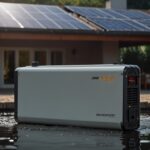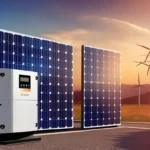In recent years, the global shift towards renewable energy sources has been remarkable, with solar power taking center stage as a clean and sustainable solution to our energy needs. Solar farms, large installations of solar panels that convert sunlight into electricity, have sprouted up across landscapes, contributing to the reduction of greenhouse gas emissions and dependence on fossil fuels. However, as with any technological advancement, there are potential drawbacks that need careful consideration. One significant concern that has emerged is the potential health risks associated with living near a solar farm. In this article, we will delve into the disadvantages of Living Near a Solar Farm, and we will include all the health risks associated with it.
7 Disadvantages of Living Near a Solar Farm
Electromagnetic Fields (EMF) Exposure
One of the primary health disadvantages of living near a solar farm is exposure to electromagnetic fields (EMF). Solar panels generate electricity through the photovoltaic effect, which involves the movement of electrons in the panels’ cells. This process produces low-frequency EMFs. While the World Health Organization (WHO) states that there is no conclusive evidence linking low-level EMF exposure to adverse health effects, some studies have suggested potential risks.
Long-term exposure to elevated EMF levels has been associated with health issues such as increased risk of cancer, particularly childhood leukemia, and other potential effects on the nervous system. Although the EMF emissions from solar panels are generally considered low, those living in close proximity to a solar farm might experience prolonged exposure, which could raise concerns, especially for sensitive individuals like pregnant women and children.
Glare and Visual Impact
Solar farms consist of thousands of solar panels, each equipped with reflective surfaces designed to capture and concentrate sunlight. While this is essential for energy production, it can also lead to issues related to glare. Glare occurs when sunlight reflects off the panels’ surfaces, creating intense bursts of light that can be discomforting and potentially hazardous to the eyes.
For residents living near a solar farm, glare can disrupt daily activities and decrease overall quality of life. Glare may also pose risks to road safety, especially if solar panels are installed near highways or roads where drivers could be temporarily blinded, leading to accidents. Although solar farm developers often take measures to mitigate glare, its potential impacts on health and safety should not be underestimated.
Noise Pollution
While solar panels themselves do not produce noise during operation, the equipment used in the construction and maintenance of solar farms can generate noise pollution. The installation process often involves heavy machinery, such as excavators and pile drivers, which can produce significant levels of noise that disrupt the tranquility of nearby communities.
Moreover, inverter stations, which are essential components of solar farms that convert the generated DC electricity into AC electricity for distribution, can emit a constant humming noise during operation. For individuals living in close proximity to these stations, this persistent noise could lead to sleep disturbances, stress, and other negative health impacts associated with noise pollution.
Land Use and Ecological Concerns
Beyond the direct health risks, the establishment of solar farms also raises concerns about land use and ecological disruption. Large-scale solar farm installations require vast expanses of land, often leading to the conversion of agricultural areas, natural habitats, or even forests into solar farms. This land transformation can disrupt local ecosystems, displace wildlife, and alter natural drainage patterns, potentially affecting water quality and soil fertility.
These ecological changes can indirectly impact human health by reducing the availability of natural spaces for recreation, increasing the risk of flooding due to altered water runoff, and even affecting air quality as vegetation in solar farm is removed. Therefore, the health consequences of living near a solar farm go beyond the immediate physical impacts and extend to the broader ecosystem-level changes brought about by land use conversion.
Psychological and Societal Impacts
The introduction of a solar farm into a previously pristine landscape can also have psychological and societal impacts on the communities living nearby. The change in scenery and the presence of large, industrial structures can lead to a decreased sense of place attachment and overall well-being among residents.
Furthermore, some individuals might experience “not in my backyard” (NIMBY) sentiments, resisting the installation of solar farms near their homes due to concerns about property values, aesthetics, and health risks. These sentiments can lead to community conflicts, straining social cohesion and exacerbating stress levels among residents.
Heat Stress and Heat Island Effect
Solar panels can also contribute to heat stress and the urban heat island effect, particularly in warm climates. The dark surfaces of the panels absorb heat, causing surrounding temperatures to rise. This increase in temperature can lead to heat exhaustion, heat stroke, and other heat-related illnesses for people working or living nearby. Additionally, the heat generated by solar panels can exacerbate the urban heat island effect, making cities even hotter than they already are.
A study conducted by the University of California, Berkeley, found that solar panels can increase local temperatures by up to 5 degrees Celsius. The study suggested that planting vegetation around solar panels can help reduce the heat island effect and lower surrounding temperatures. Solar farm operators can also use reflective coatings or lighter-colored panels to minimize the amount of heat absorbed by the panels.
Fire Hazards
Solar panels can also pose a fire hazard, particularly if they are not properly maintained or installed. A malfunctioning panel can overheat and ignite, spreading fire quickly across the solar array. Dry vegetation and debris spreading fires quickly across the solar array. The risk of fires is heightened during periods of extreme heat and drought, which are becoming more frequent due to climate change.
In addition to the direct damage caused by fires, smoke and ash from burning solar panels can also pose health risks to people living nearby. Inhaling smoke and ash can irritate respiratory systems and aggravate existing conditions like asthma. Moreover, the chemicals used in solar panels, such as polyvinyl chloride (PVC), can release harmful dioxins when burned, further increasing the health risks associated with solar panel fires.
Conclusion
As the world embraces solar energy as a key component of the renewable energy landscape, it is vital to acknowledge and address the potential disadvantages associated with living near solar farms. While solar energy offers numerous environmental benefits, including reduced greenhouse gas emissions and decreased reliance on fossil fuels, it is crucial to balance these advantages with the health risks and other concerns that can arise from proximity to solar installations.
















